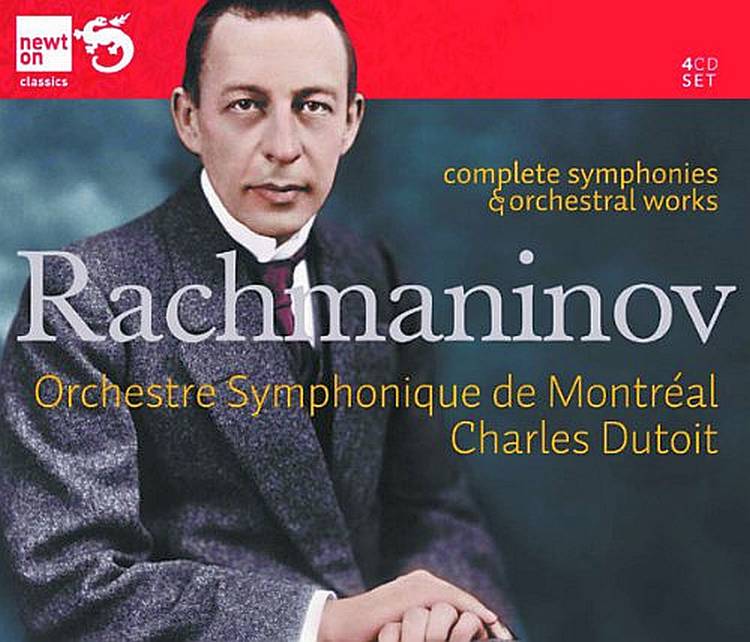Logowanie
KOLEKCJE!
BACH, CHOPIN, LISZT, MOZART, GRIEG, Dinu Lipatti, Otto Ackermann, Ernest Ansermet
The Master Pianist
PROKOFIEV, CHOPIN, TCHAIKOVSKY, SCHUMANN, BEETHOVEN, Martha Argerich, Claudio Abbado, Giuseppe Sinopoli
The Concerto Recordings
The Collection 2
Jakość LABORATORYJNA!
ORFF, Gundula Janowitz, Gerhard Stolze, Dietrich-Fischer Dieskau, Deutsche Oper Berlin, Eugen Jochum
Carmina Burana
ESOTERIC - NUMER JEDEN W ŚWIECIE AUDIOFILII I MELOMANÓW - SACD HYBR
Winylowy niezbędnik
ClearAudio
Essence MC
kumulacja zoptymalizowana: najlepsze z najważniejszych i najważniejsze z najlepszych cech przetworników Clearaudio
Direct-To-Disc
PIAZZOLLA, ChamberJam Europe
Tangos del Ángel y del Diablo
Direct-to-Disc ( D2D ) - Numbered Limited Edition
RACHMANINOV, Philadelphia Orchestra, Charles Dutoit
Complete Symphonies / Symphonic Dances / The Bells / Isle of the Dead etc.
- CD 1
- Symphony No. 1 in D minor, Op. 13
- 1. I. Grave - Allegro ma non troppo - Moderato - Allegro vivace - L'istesso tempo - Allegro Molto - 13:43
- 2. II. Allegro animato - Meno mosso - Tempo I - 09:29
- 3. III. Larghetto - Piu mosso - Largo un poco - Con moto - Tempo I - 10:34
- 4. IV. Allegro con fuoco, Marciale [sempre marcato] - Con animo - Allegro mosso - Allegro con fuoco - Presto - Largo - 12:22
- 5. Ostrov myortvikh (The Isle of the Dead), Op. 29 - 21:05
- CD 2
- Symphony No. 2 in E minor, Op. 27
- 1. I. Largo - Allegro moderato - 19:48
- 2. II. Allegro molto - 09:32
- 3. III. Adagio - 13:38
- 4. IV. Allegro vivace - 14:18
- Utyos (The Rock), Op. 7
- 5. The Rock, Op. 7 - 14:25
- CD 3
- Symphony No. 3 in A minor, Op. 44
- 1. I. Lento - Allegro moderato - 15:53
- 2. II. Adagio ma non troppo - 12:32
- 3. III. Allegro - 12:23
- Symphonic Dances, Op. 45
- 4. I. Non allegro - 11:04
- 5. II. Andante con moto (Tempo di valse) - 09:13
- 6. III. Lento assai - Allegro vivace - Lento assai - Come prima - Allegro vivace - 13:23
- CD 4
- Konstantin Dmitriyevich Balmont, lyricist(s)
- Kolokola (The Bells), Op. 35
- 1. I. Allegro, ma non tanto - 06:18
- 2. II. Lento - 10:20
- 3. III. Presto - 08:07
- 4. IV. Lento lugubre - Allegro - Andante - Tempo I - 10:34
- Nikolai Alekseyevich Nekrasov, lyricist(s)
- 5. Vesna (Spring), Op. 20 - 15:59
- 3 Russian Songs, Op. 41
- 6. No. 1. Over the stream, the swift stream - 03:18
- 7. No. 2. Ah, Vanka, you are so dashing - 05:09
- 8. No. 3. My cheeks, so white, so rosy! - 03:39
- Łączny czas: 04:36:46
- Philadelphia Orchestra - orchestra
- Charles Dutoit - conductor
- RACHMANINOV
For many years Rachmaninov’s symphonic output was neglected, and it wasn’t until the 1970s that the Second of his three symphonies was heard in its original uncut version. Slowly the realisation that this work and the masterful Third Symphony and Symphonic Dances were indeed able to stand comparison with the best of the symphonic repertoire finally dawned. They are now standard repertoire for most of the major orchestras, and as popular as the piano concertos with the public. The Philadelphia Orchestra was Rachmaninov’s favourite, and the sound that it became famous for under Leopold Stokowski suits his music well. These recordings were praised for their sound upon release in the 1990s, and Charles Dutoit captures the ‘Philadelphia Sound’ admirably. Rachmaninov’s own recording of the Third symphony was made with this orchestra, who premiered it under Stokowski in 1936. ‘Compared with other versions, Dutoit’s performance of The Bells is remarkable for subtle pianissimos and half tones rather than dramatic bite…but helped by the dynamic range of the atmospheric recording, it is still an impressive performance.’ Gramophone, August 1994 Charles Dutoit and the Philadelphia Orchestra recorded the three symphonies and major orchestral works of Sergey Rachmaninov between 1992 and 1995 for Decca, and these recordings have been reissued together as a four-CD set by Newton Classics. The brooding post-Romantic music of this Russian master poses special problems for conductors because the orchestration is often dense and low-to-middle range, so some selectivity in the balancing of sections is required for clarity’s sake. Dutoit makes the textures reasonably clear and draws out distinctive tone colors wherever possible, so this set is not as murky sounding as some, though much of the weightiness of these scores was certainly intended by Rachmaninov. The Philadelphia Orchestra is a little less lush here than in its famous recordings with Eugene Ormandy, where a rich string tone, woodwind doublings, and heightened attacks dominated the performances. Here, Dutoit keeps the strings’ vibrato in check and generally saves the orchestra’s huge sonorities for the big moments, so the music doesn’t seem overblown or overly emotional, charges that are sometimes leveled at these pieces when they are carelessly played. Because the recordings were all-digital, the sound is clean and clear, and the orchestra has credible presence. (Blair Sanderson - Allmusic.com, November 2010)

























